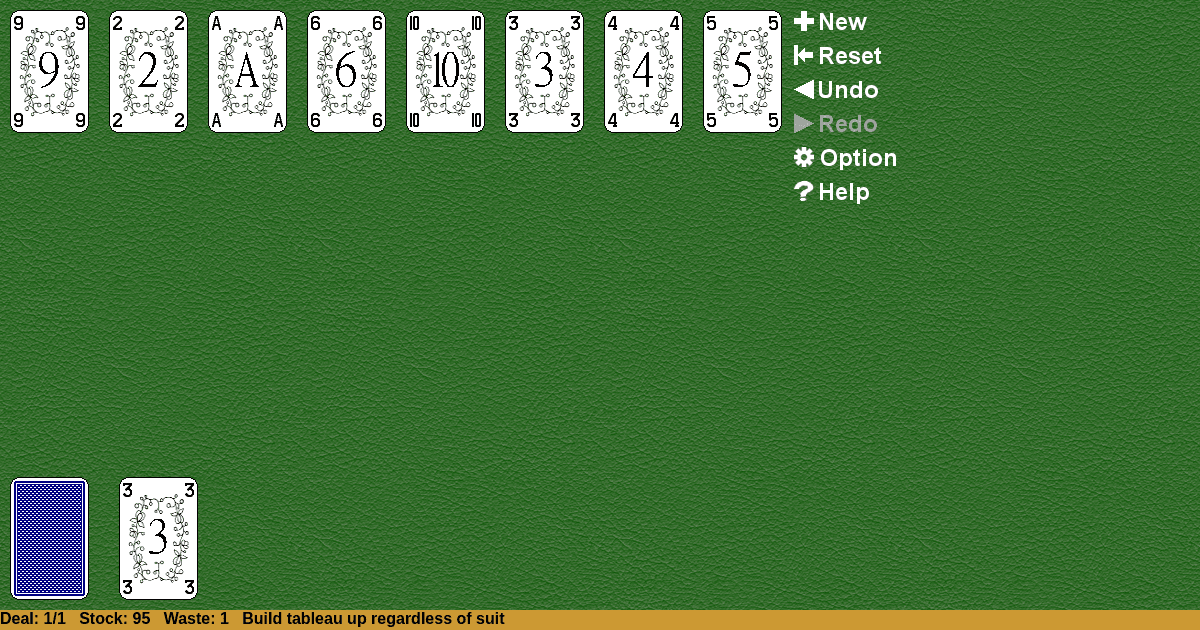German
Home |
How to play |
FAQ |
About
How to play German?
Game Objective:
The primary goal in German Solitaire is to build eight complete sequences of 13 cards each on the tableau piles, with each sequence built up in rank (regardless of suit), wrapping from King to Ace as necessary, so that each pile contains a continuous run of 13 cards.
Setup & Layout:
- Deck: Use two standard 52-card decks shuffled together (104 cards total).
- Tableau: Deal eight cards face-up in a horizontal row to form eight tableau piles (also called foundations in some sources).
- Stock: Place the remaining 96 cards face-down as the stock pile.
- Waste: The waste pile is created during play by turning cards from the stock face-up, one at a time.
- Face-up/Face-down: All tableau cards are dealt face-up. The stock is face-down; cards moved to the waste are face-up.
Key play areas:
- Tableau (8 piles): Where sequences are built.
- Stock: Supplies new cards.
- Waste: Holds cards turned from the stock, with only the top card available for play.
German Solitaire Rules:
- Building Sequences:
- Build up on the tableau piles in rank, regardless of suit (e.g., 7♣, 8♦, 9♠, 10♥, etc.).
- Sequences wrap from King to Ace (i.e., after King comes Ace, then 2, 3, etc.).
- Each pile starts with its base card (the card dealt at setup) and builds up until it contains 13 cards, ending with the card one rank below the starting card (e.g., if a pile starts with 7, it ends with 6).
- Moving Cards:
- Only the top card of each tableau pile or the top card of the waste pile may be moved.
- Cards can be moved to any tableau pile if they are the next higher rank (regardless of suit) and continue the sequence.
- Empty Spaces:
- Any card may be moved to fill an empty tableau pile (space).
- Stock and Waste:
- Turn over one card at a time from the stock to the waste pile.
- The top card of the waste is always available for play on the tableau.
- In most versions, there is no redeal; once the stock is exhausted, play continues only with available tableau and waste cards.
- Some variants allow a single redeal, returning the waste to the stock and continuing play.
Gameplay:
- Turn Sequence:
- Move cards among tableau piles, building up in rank as allowed.
- Fill any empty tableau spaces with any available card.
- When no moves are possible, turn a card from the stock to the waste.
- Play the top waste card to the tableau if possible.
- Repeat until all cards are played or no moves remain.
- Introducing New Cards:
- New cards enter play only via the stock, dealt one at a time to the waste pile.
- No More Moves:
- If the stock is empty and no further moves can be made using tableau and waste cards, the game ends.
Winning & Losing Conditions:
- Winning Condition:
- The game is won when all eight tableau piles each contain a complete sequence of 13 cards, built up in rank (regardless of suit), wrapping as necessary, with each sequence starting with its initial base card and ending with the card one rank below it.
- Losing Condition:
- The game is lost (unwinnable) if the stock is exhausted and no further legal moves are possible, leaving incomplete sequences on the tableau.
Special Rules & Edge Cases:
- Filling Empty Spaces:
- Any available card (from the tableau or waste) may be moved to fill an empty tableau pile at any time.
- Sequence Wrapping:
- Sequences wrap from King to Ace, so after King, Ace may be placed, followed by 2, 3, etc..
- Redeal Variants:
- The standard rule is no redeal; however, some versions allow a single redeal, returning the waste to the stock and continuing play. After the redeal, only the top card of the waste may be played, and no further redeals are allowed.
- Building Direction:
- The standard is to build up in rank, but some sources note that building down is a possible variant, producing similar gameplay.
- Multiple Moves:
- Only one card may be moved at a time; sequences cannot be moved as a group.
Note: German Solitaire is considered very difficult to win, with a win rate of around 1%. Strategic use of empty spaces and careful management of the waste are essential for success.

Solitaire Collection
About German
Rate (German)
4.7 / 5
1,916 votes



























































